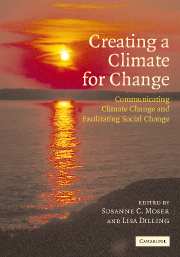Book contents
- Frontmatter
- Contents
- Preface
- Foreword
- List of contributors
- List of tables
- List of figures
- List of text boxes
- Introduction
- Part I Communicating climate change
- Part II Facilitating social change
- Part III Creating a climate for change
- 31 An ongoing dialogue on climate change: The Boulder Manifesto
- 32 Toward the social tipping point: creating a climate for change
- About the authors
- Index
- References
32 - Toward the social tipping point: creating a climate for change
Published online by Cambridge University Press: 20 August 2009
- Frontmatter
- Contents
- Preface
- Foreword
- List of contributors
- List of tables
- List of figures
- List of text boxes
- Introduction
- Part I Communicating climate change
- Part II Facilitating social change
- Part III Creating a climate for change
- 31 An ongoing dialogue on climate change: The Boulder Manifesto
- 32 Toward the social tipping point: creating a climate for change
- About the authors
- Index
- References
Summary
Introduction
Over the course of the project that culminated in this book, the landscape of climate change science, communication, and related societal responses has changed remarkably – both in the United States and elsewhere. Considering the entirety of what political scientists call the global warming “issue domain” (Jenkins-Smith and Sabatier 1999; Clark et al., 2006), we have witnessed considerable movement, including the growing number of actors involved, and shifts in their “goals, interests, beliefs, strategies, and resources; the institutions that enable and constrain interactions among those actors; the framings, discourse, and agenda related to the issue; and the existing policies and behaviors of relevant actors” (Clark et al., 2006).
In this concluding chapter, we have five goals. First, we reflect on where we are in the evolution of the climate change issue domain, and then develop a simple conceptual framework to integrate the many perspectives offered in preceding chapters on the role communication can play – in principle – in facilitating social change. Next we dispel a number of myths still prevalent among communicators and social change agents that we believe hinder change. Fourth, we extract larger lessons from the chapters that could improve climate change communication and advance the evolution of this issue domain. Finally, we suggest questions for future research and action steps. The collective experience represented in this volume suggests that these research directions and action steps can further support effective communication and responses to climate change in ways that help move all levels of society toward an environmentally, economically, and socially more sustainable future.
- Type
- Chapter
- Information
- Creating a Climate for ChangeCommunicating Climate Change and Facilitating Social Change, pp. 491 - 516Publisher: Cambridge University PressPrint publication year: 2007
References
- 49
- Cited by

